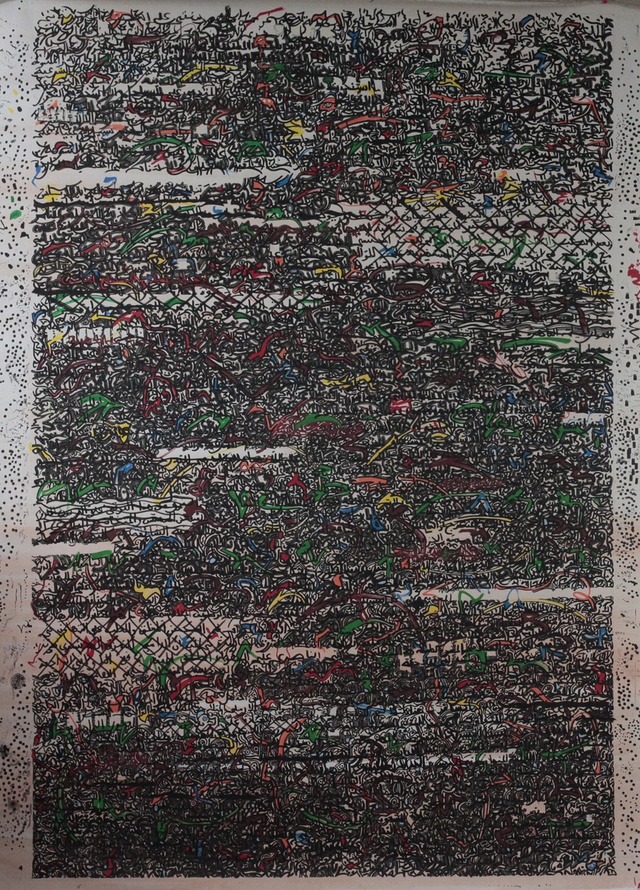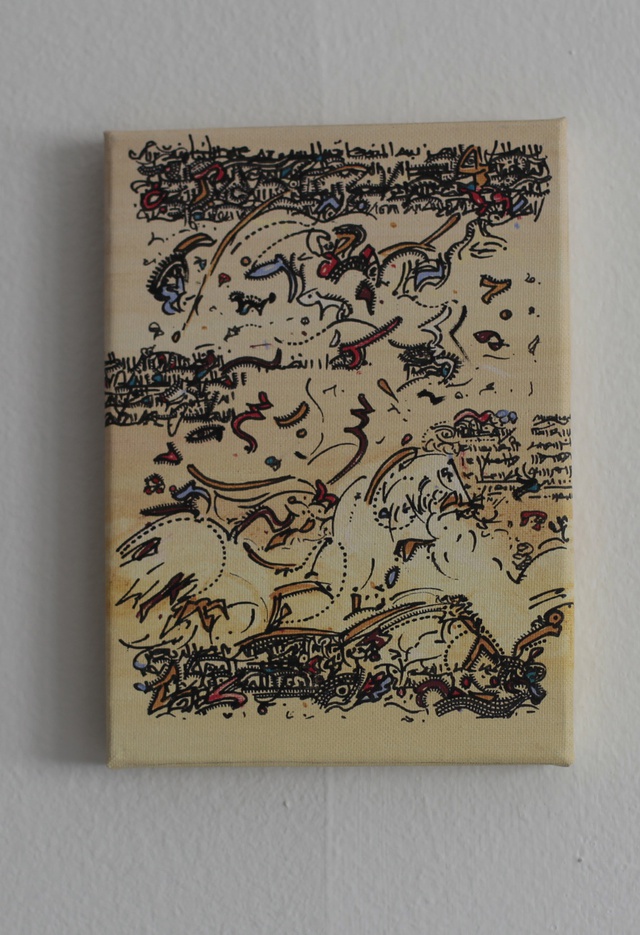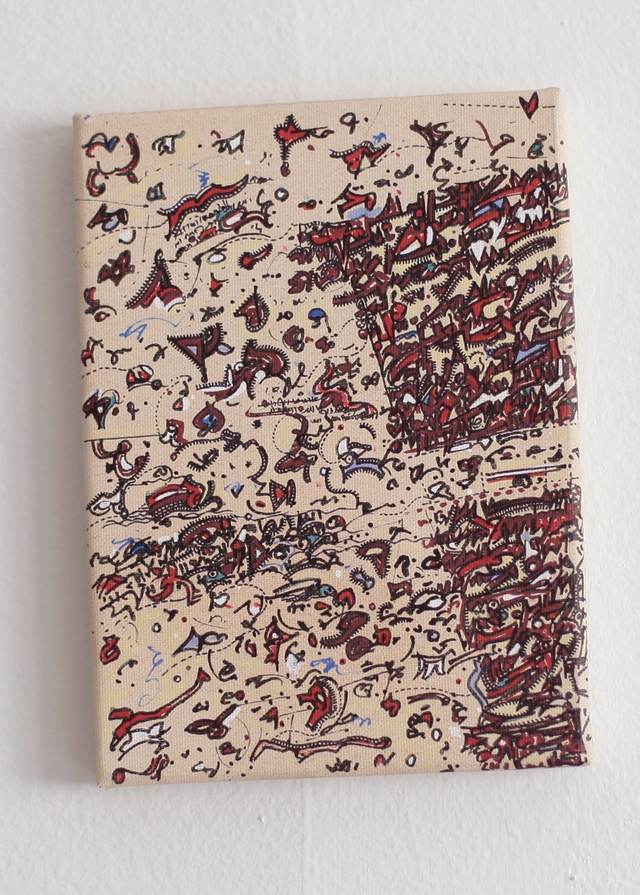Reviews
Imed Jemaïel’s Talismanic Paintings/Les tableaux talismans de Imed Jemaïel
Le Dessous des Ratures (Beneath the Crossings Out)
What struck me the most when my eyes met the paintings titled Le Dessous des Ratures (Beneath the Crossings Out) was this hymn to writing, this crazy language made out of a combination of Berber symbols, Aztec art, parchment, an old writing tablet, a manuscript of a contract from times gone by with their famous signatures and all manner of other things.
Strange is this tangle of zips with white teeth, these caterpillars in single file, these stretches of railway lines that divert from their route and intermingle, winding between the shapes and the colours and all those eyes watching us!
In reality, all these readings that seek to identity the piece anecdotally are secondary in the face of this dilemma: the visual illusion that the artist throws us into with his painting-writings.
Originally, drawing and writing are one and the same
For Imed Jemaïel, writing, drawing and painting are but one activity. Of course, our painter-writer is merely reaffirming the ancient definition of what Neanderthal men were doing when they drew animals on the walls of the Lascaux caves in a quest for understanding – not to communicate and even less so to decorate, as some people might interpret it.
Indeed, at its root, does the verb graphein in Ancient Greek not mean both to draw and to write? The truth is that the symbols which were created by man, whether for the purpose of drawing or writing, made no distinction between the two actions.
Last year, after at least two decades of practice related to the problematic of writing-drawing and going in search of art in the city of arts and literature, Paris, Jemaïel unearthed a tool – a tracing implement which allows you to paint with a pen. Filled with acrylic, the artist used it to print and trace like a draughtsman on a canvas; the result is these crossings out, but what crossings out they are! They are more like mysterious signs which seem determined to guard the secret of their meaning. Pregnant canvases, silently proud, with an enormous amount of harnessing power.
To us, it seems our fascination comes from the condensed quality of black that is set against the immaculately white canvas. Through this act of marking, which strikes the face of the printer's stamp as he carries out his work, Imed the trainee engraver takes action.
Within this extreme light-dark contrast are rare notes of luminous yellow ochre, then another coloured green – a symbol of paradise for some – which emerge from the canvas and ultimately establish a perfect equilibrium. Does the darkness and the light, the cheated dream symbolized by the gilding, not therefore constitute the fate of the human condition on this earth?
By adopting horizontality a love of reading and writing, Jemaïel merely continues to adopt the position that every reader holds. Thus, his bodily position, sitting or standing, follows the direction of a straight horizontal line, which usually starts from the right and runs through to the left side of the canvas. And so goes the painting, from right to left and from top to bottom. In the same way I saw him start off in his studio, the artist begins by applying a few notes of colour across the canvas, then working through piece by piece. Next he links the composite parts together, keeping intact the horizontal path of the lines and shapes. The striking aspect of the work is the patience with which the plastic material is embroidered, like lace spreading out.
Consequently, without straying from the canvas and the frame, but a million miles away from a picture in classical painting, the hand of the artist paints and writes at the same time, while in the course of his creative process he negotiates the overall structure of the painting-to-be, as does a classical painter.
A Creative Process of Unveiling
Finally, in questioning the painter-writer and tracer of acrylic on what new and added things this adventure has given him, and following his revealing silence, I feel as though I have penetrated a part of the secret of his paintings – the link with the wooden tablets of our Tunisian heritage. In those days the teacher would write on the wooden tablets and give them to the children to recite from. Standing alongside the text were triangular geometric shapes in vivid colours, like those we see in Beneath the Crossings Out.
Once the text had been learnt, the teacher would start erasing it, although it was never true erasure – the tablet was covered in a layer of fresh clay onto which, when dry, a new passage was written. Instantaneously, the pages of an immaterial book were superimposed on top of one other without one noticing.
Contrary to this palimpsest method, the approach of artist Imed Jemaïel is an unveiling par excellence; what he has crossed out remains visible and noticeable in the form of a malleable language open to all emotions and all evocations, even if paradoxically the canvases remain somehow closed when it comes to their mystery as talismanic objects. Ultimately, the works evoke the question of a two-way paradox – between what can be perceived and that which remains a mystery.
Le Dessous des Ratures (Beneath the crossings out) ran from 6 to 27 April 2014 at A Gorgi, Sidi Bou Saïd, Tunisia.
Les tableaux talismans de Imed Jemaïel
« Le Dessous des ratures » exposition qui s'est déroulée du 06 au 23 avril 2014, A la galerie A Gorgi, Sidi Bou Saïd.
Le fait saillant qui s'est exercé sur ma perception lorsque mon regard a rencontré les tableaux en grand, moyen et petit format nommés « Le Dessous des ratures », est cet hymne à l'écriture, ce fou langage construit d'une synthèse de signes berbères, d'art aztèque, de parchemin, d'enluminure, d'ancienne tablette, de manuscrit de contrat d'autrefois avec leurs fameuses signatures et de je ne sais quoi d'autre.
Etrange est cet enchevêtrement de fermetures éclair aux dents blanches, ces chenilles à la queue leu leu, ces bouts de rails qui déroutent et s'entremêlent en serpentant entre les formes et les couleurs et tous ces yeux qui nous regardent !
En vérité, toutes ces lectures d'identification anecdotiques sont secondaires face à ce dilemme : le leurre visuel dans lequel le plasticien nous jette par ses peintures-écritures.
A l'origine dessiner et écrire font un
Avec Imed Jemaïel, écrire, dessiner et peindre ne sont qu'une seule et unique activité. Certes, notre peintre-écrivant ne fait que confirmer la définition ancienne de l'activité des hommes du Neandertal lorsqu'ils dessinaient les animaux sur les parois des grottes de Lascaux dans un but de connaissance, et non pas pour communiquer et encore moins pour décorer comme pourrait l'interpréter le commun des mortels.
En effet à l'origine, le verbe graphein du grec ancien ne signifie-il pas dessiner et écrire à la fois ! En vérité, les signes qui ont été créés par les hommes que ce soit pour dessiner ou écrire, ne font pas de distinction entre l'une ou l'autre action.
Imed après au moins deux décennies de pratique sur la problématique de l'écriture-dessin, en allant l'année dernière à la rencontre de l'art dans la ville des arts et des lettres Paris, a déniché un outil, un traceur qui permet de peindre avec un stylo. Rempli d'acrylique, notre artiste l'a utilisé pour inscrire comme un script et tracer comme un dessinateur sur une toile; le résultat est ces dessous de ratures, mais quelles ratures ! Plutôt des signes mystérieux qui semblent vouloir garder le secret de leurs signifiés. Toiles enceintes, silencieusement fières et contenant une énorme dose de pouvoir de captation.
Justement à notre avis, notre fascination provient de la présence de la valeur condensée du noir qui s'oppose à la toile immaculée blanche. A travers ce marquage qui frappe le regard du sceau de l'imprimeur lorsqu'il effectue son travail, Imed le graveur de formation, agit.
Parmi tout ce contraste clair-obscur allant de l'extrême obscurité à l'extrême clarté, une rare note d'ocre jaune lumineuse puis une autre de couleur verte, symbole de paradis pour certains, émergent dans le tableau et finissent par établir le parfait équilibre. Ainsi, la clarté et l'obscurité, le rêve berné symbolisé par la dorure ne constituent-ils pas le lot de la condition de l'être humain sur cette terre!
En adoptant l'horizontalité, notre plasticien passionné de lecture et d'écriture, ne fait que continuer à adopter la posture qui engage tout lecteur. Ainsi, sa position corporelle assise ou debout suit la direction d'une ligne droite horizontale qui commence souvent à droite et se poursuit jusqu'à la limite gauche de la toile. Et ainsi va le tableau, de droite à gauche et de haut en bas. Mais tel que je l'ai vu procéder dans son atelier, notre plasticien commence par mettre quelques notes de couleurs à travers la toile, puis travaille fragment par fragment, ensuite il lie les composantes entre elles, gardant présente la direction horizontale des lignes et des formes. L'aspect frappant dans ce travail est la patience avec laquelle le tissu plastique se brode, telle une dentelle qui se répand.
Donc, sans se départir de la toile et du châssis, mais à mille lieux du tableau de peinture classique, la main du plasticien peint et écrit à la fois, même si au cours de son processus créateur il traite la structure globale de son futur tableau, comme le fait un peintre classique.
Un processus créateur de dévoilement
Au bout du compte, et en questionnant l'auteur peintre-écrivant au traceur d'acrylique, sur ce que cette aventure lui a apporté de plus et de neuf, et à la suite de son silence révélateur, je pense avoir percé une part du secret de ses peintures en faisant la jonction avec la notion des tablettes de bois de notre patrimoine tunisien d'autrefois. En effet, l'instituteur d'alors écrivait sur des tablettes de bois qu'il donnait à réciter aux enfants. Côtoyant le texte, sur la tablette figuraient aussi des formes géométriques triangulaires aux couleurs vives comme ce que nous voyons sur « Le Dessous de ratures ».
Une fois le texte appris, le maître procédait à l'effacement – qui n'en est pas un – du texte, car il recouvrait la tablette d'une couche d'argile fraîche, puis attendait que celle-ci sèche et il se remettait à transcrire un nouveau texte à apprendre. Et ainsi de suite, les pages d'un livre immatériel se superposaient sans qu'on les aperçoive.
Contrairement à ce procédé de palimpseste, l'approche du plasticien Imed Jemaïel est par excellence celle du dévoilement, point besoin de recouvrir et de cacher, ce qu'il « a raturé » reste visible et perceptible sous la forme d'un langage plastique ouvert à toutes les émotions et à toutes les évocations, même si paradoxalement, les tableaux demeurent en quelque sorte fermés sur leurs mystères d'objets talismaniques. En outre, il s'agit d'un double paradoxe entretenu entre le perceptible et le mystérieux.

















